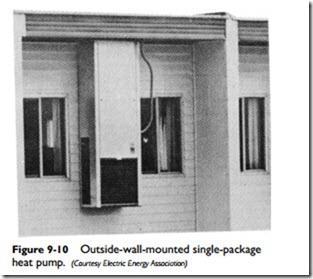Electric Space Heaters
Smaller unit heaters designed and constructed for domestic heating purposes are commonly referred to as space heaters. Like the larger units, they are also designed to operate with other heat-conveying mediums. However, the advantage of using electric space heaters over the fuel-burning types is that they do not have to be vented and require no flue.
Space heaters are available as either portable or permanent types. The latter can be fitted into ducts or mounted on walls or the ceiling.
For further information on space heaters see the appropriate sections in Chapter 2 of Volume 3, “Radiators, Convectors, and Unit Heaters.”
Heat Pumps
A heat pump (Figures 9-9 and 9-10) is an electrically powered, reversible-cycle refrigeration unit capable of both heating and cooling the interior of a structure.
The heat source is commonly either outside air (in the air-to-air heat pump) or a closed loop of circulating water (in the water-to-air heat pump). The former is the most popular heat pump used for single-family dwellings. The water-to-air heat pump system is most often found in multifamily structures. These are essentially central heating systems, with the heat pump replacing the central furnace or boiler as the heat-generating unit.
Operating valves in the heat pump unit control the reversal of the refrigeration cycle. It removes heat from the interior of the structure, discharges it outside during hot weather, and supplies heat to the interior spaces during periods of cold weather.
The basic components of a heat pump installation are (1) the compressor, (2) the condenser, (3) the evaporator, and (4) a low- voltage thermostat. These and other aspects of heat pumps are described in greater detail in Chapter 12 of Volume 3.

